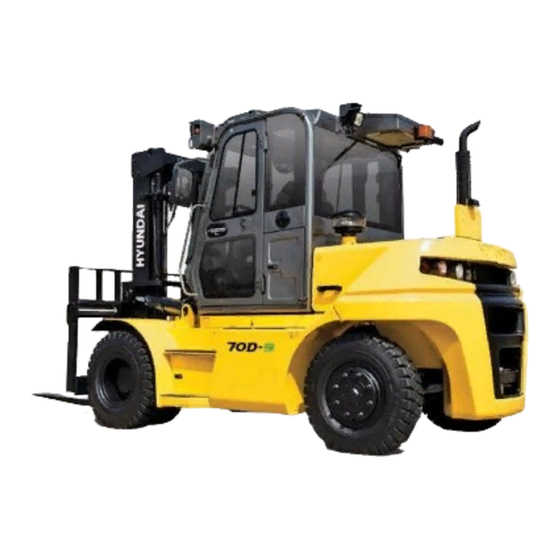
Table of Contents
Advertisement
Quick Links
FOREWORD
FOREWORD
A message to hyundai lift truck operators ----------------------------------------------------------------------- 0-1
Introduction ------------------------------------------------------------------------------------------------------------------------ 0-2
How to use this manual ----------------------------------------------------------------------------------------------------- 0-3
EC regulation approved ---------------------------------------------------------------------------------------------------- 0-5
Safety labels ----------------------------------------------------------------------------------------------------------------------- 0-6
Guide (Direction, Serial number, Symbols) --------------------------------------------------------------------- 0-13
1. Daily inspection -------------------------------------------------------------------------------------------------------------- 1-1
2. Do's and don'ts -------------------------------------------------------------------------------------------------------------- 1-2
3. Seat belts ----------------------------------------------------------------------------------------------------------------------- 1-4
4. No riders ------------------------------------------------------------------------------------------------------------------------- 1-5
5. Pedestrians -------------------------------------------------------------------------------------------------------------------- 1-6
6. Operator protection ------------------------------------------------------------------------------------------------------- 1-7
7. Fork safety ------------------------------------------------------------------------------------------------------------------ 1-8
8. Pinch points ---------------------------------------------------------------------------------------------------------------- 1-9
9. Travel ------------------------------------------------------------------------------------------------------------------------------ 1-10
10. Grades, ramps, slopes and inclines ---------------------------------------------------------------------------- 1-11
11. Tip over -------------------------------------------------------------------------------------------------------------------------- 1-12
12. Surface and capacity ---------------------------------------------------------------------------------------------------- 1-14
13. Parking --------------------------------------------------------------------------------------------------------------------------- 1-15
14. Refueling ------------------------------------------------------------------------------------------------------------------------ 1-16
15. Step -------------------------------------------------------------------------------------------------------------------------------- 1-17
16. Operator's safety rules -------------------------------------------------------------------------------------------------- 1-18
17. Side shift ------------------------------------------------------------------------------------------------------------------------ 1-19
1. Loose loads -------------------------------------------------------------------------------------------------------------------- 2-1
2. Long and wide loads ----------------------------------------------------------------------------------------------------- 2-2
3. Rear swing --------------------------------------------------------------------------------------------------------------------- 2-2
4. Low overhead clearance ----------------------------------------------------------------------------------------------- 2-3
5. Fast turns and high loads ---------------------------------------------------------------------------------------------- 2-3
6. Right angle stacking ------------------------------------------------------------------------------------------------------ 2-4
7. Chain slack --------------------------------------------------------------------------------------------------------------------- 2-4
8. Pallets and skids ------------------------------------------------------------------------------------------------------------ 2-5
9. Caution for electrical lines --------------------------------------------------------------------------------------------- 2-5
CONTENTS
CONTENTS
Advertisement
Table of Contents








Need help?
Do you have a question about the 50D-9 and is the answer not in the manual?
Questions and answers